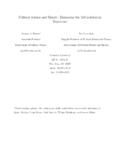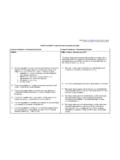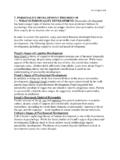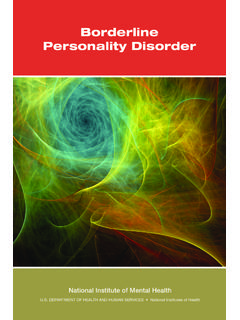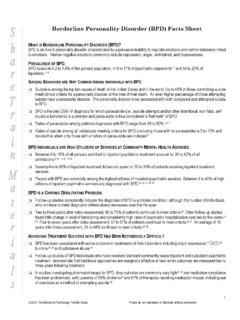Transcription of Diagnosis and Assessment of Personality Disorders
1 Diagnosis and Assessment of Personality Disorders Michael B. First, Editor, DSM-IV Text and Criteria Department of Psychiatry, columbia university What is a Personality Disorder? an enduring pattern of inflexible and maladaptive thinking, feeling, and acting that cause significant subjective distress and/or impairment in social or occupational functioning. contrasted with Personality traits: pattern of experiencing and interacting with environment and other people boundary is inherently blurry Disorder vs. Trait Conscientiousness and scrupulosity in small doses is advantageous (trait). In the extreme, leads to paralyzing over attention to detail with interferes with finishing tasks (disorder).
2 Some traits are maladaptive at either extreme: Too little trust: paranoid Too much trust: gullibility leading to being taken advantage of DSM-IV Criteria for must meet these six criteria to be considered a Personality disorder (including NOS). operationalizes what is a Personality disorder? . DSM-IV Criterion A. A. An enduring pattern of inner experience and behavior that deviates markedly from the expectations of the individual's culture, manifested in at least 2 of the following areas: (1) cognition ( , ways of perceiving and interpreting oneself, other people, and events). DSM-IV Criterion A. (2) affectivity ( , the range, intensity, lability, and appropriateness of emotional response).
3 (3) interpersonal functioning (4) impulse control DSM-IV Criterion A. Assessment requires consideration of inner experience as well as overt behavior need to balance reliability of behavioral items ( , ASP items) with validity of inferential items ( , identity disturbance). cultural expectations critical - , behavior considered histrionic in culture that values restraint would be norm in culture that values spontaneity DSM-IV Criterion B. B. The enduring pattern is inflexible and pervasive across a broad range of personal and social situations behavior restricted to one person or situation is relational problem or Adjustment Disorder inflexibility is reason for maladaptive and enduring nature (self-fulfilling).
4 DSM-IV Criterion C. C. The enduring pattern leads to clinically significant distress or impairment in social, occupational, or other important areas of functioning. impairment on continuum - traits vs. disorder DSM-IV Criterion C. complicating factors in determining significance: ego-syntonic nature reluctance to acknowledge unflattering traits denial or exaggeration may be characteristic of certain clinician's clinician's culture clinician's gender bias DSM-IV Criterion D. D. The pattern is stable and of long duration and its onset can be traced back at least to adolescence or early adulthood can be diagnosed in childhood? with caution so long as it is pervasive, persistent, and unlikely to be limited to a particular developmental stage or an episode of an Axis I Disorder.
5 DSM-IV Criteria for - V. E. The enduring pattern is not better accounted for as a manifestation or consequence of another mental disorder. confirm long-standing duration prior to and independent of Axis I condition and determine the degree to which the features persist even as the Axis I symptoms remit. Axis I vs. Axis II. Axis II created to counteract underrecognition of in pre- pre-DSM- DSM-III days important not to overdiagnose ( , borderline . borderline . for irritability and lability). do not reify Axis I/Axis II distinction -- many Axis I. Disorders are chronic with early onset ( , Dysthymic Disorder, Somatization Disorder). Avoidant Personality Disorder vs.
6 Social Phobia DSM-IV Criterion F. F. The enduring pattern is not due to the direct physiological effects of a substance ( , a drug of abuse, medication, toxin exposure) or a general medical condition ( , head trauma). DSM-IV Clusters 10 Personality Disorders in DSM-IV. Grouped into 3 clusters because of heuristic value Cluster A: odd (Schizoid, Schizotypal, Paranoid). Cluster B: dramatic (Antisocial, Borderline, Histrionic, Narcissistic). Cluster C: anxious (Avoidant, Dependent, Obsessive-Compulsive). Cluster A: Paranoid, Schizoid, Schizotypal Paranoid Personality Disorder tendency to be suspicious, mistrustful, hypervigilant, and preoccupied with being exploited or betrayed by others hostility, irritability, avoidance, and anxiety often secondary to the paranoid beliefs self-fulfilling prophecies.
7 Mistrustful behavior causes others to act in an overly cautious and even deceptive way Schizoid Personality Disorder profound defect in the individual's ability to form personal relationships or to respond to others in an emotionally meaningful way indifferent, aloof, detached, and unresponsive to praise, criticism, or any other feelings expressed by others Schizotypal displays idiosyncratic speech patterns, eccentric beliefs, paranoid tendencies, perceptual illusion, unusual appearance, inappropriate affect, and social anxiety some with Schizotypal go on to develop Schizophrenia (use premorbid ). Cluster B: Antisocial, Borderline, Histrionic, Narcissistic Antisocial Personality Disorder pattern of socially irresponsible, exploitative, and guiltless behavior engages in the deception and manipulation of others for personal gain fails to abide by the law, sustain consistent employment, and develop stable relationships Lacks remorse Borderline Personality Disorder pattern of intense and chaotic relationships with fluctuating and extreme attitudes toward others engage in self-destructive behaviors, are affectively unstable and impulsive, and lack a clear sense of identity.
8 Suicide attempts or self-mutilation may be a response to rejections or disappointments in interpersonal relationships Borderline Personality Disorder lives tend to be chaotic, unstable, and marked by frequent disappointments and rejections underlying mood is labile and quick to anger which may be intense in crisis or with substance use, may experience transient psychotic breaks self-mutilating behavior: "treating" dissociative symptoms or intense dysphoria or counteracting intense anger Histrionic Personality Disorder attention-seeking, self-dramatizing excessively gregarious, seductive, manipulative, exhibitionistic Shallow emotions, labile, vain, and demanding Narcissistic Personality egocentric, grandiose crave admiring attention and praise and place excessive emphasis on displaying the accoutrements of beauty, power, fame, and wealth use relationships to meet their own selfish needs with little consideration for the needs of the other person feel "entitled" to special rights, attention, privileges, and consideration Cluster C.
9 Avoidant, Dependent, Obsessive-Compulsive Avoidant Personality Disorder inhibited, introverted, and anxious behavior low self-esteem, hypersensitivity to rejection, social awkwardness, timidity, social discomfort, and self-conscious fears of being embarrassed or acting foolish Dependent Personality Disorder excessive reliance on others tendency to permit others to make important decisions, to feel helpless when alone, to subjugate needs to those of others, to tolerate mistreatment, and to be appropriately self-assertive. not uncommon for such a patient to be living with a controlling, domineering, or overprotective person Obsessive-Compulsive Perfectionistic, constricted, and excessively disciplined behavior is rigid, formal, emotionally cool, distant, intellectualizing, and detailed.
10 Driven, aggressive, competitive, and impatient, with a chronic sense of time pressure and an inability to relax. excessive tendency to be in control of themselves, others, and life situations.









